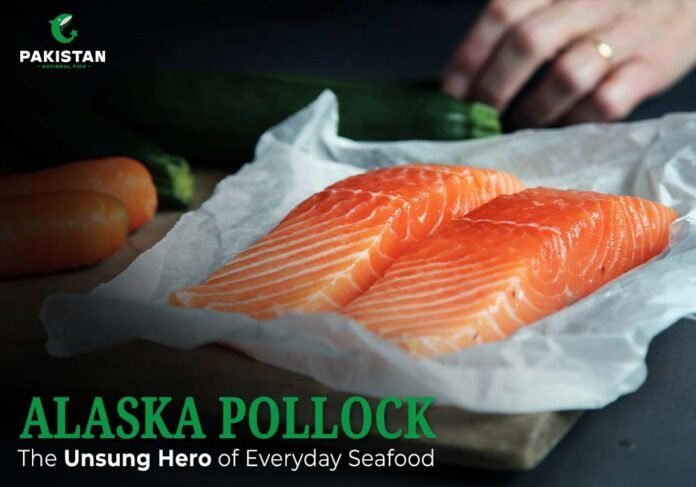At least one time in your life you have taken Alaska Pollock in your meals. Sometimes it is the part of Mexican dish taco, or inside the tender and delicious sand witches, or formed into simulated crab. This stylish white fish is not like an appearance of salmon or tuna, but it restfully acquire its kitchen spots all over the globe. It’s low-priced, subtle, compact with healthy nourishing components, and the main part is, it is founded in the most accountable fisheries on Earth.
So what is the speciality and popularity of Alaska Pollock? Let’s look into chefs, families, and seafood loved one keep coming back to this gentle-tasting favorite.
What Exactly Is Alaska Pollock?
Alaska Pollock (Gadus chalcogrammus) is part of the cod family and thrives in the cold, nutrient-rich waters of Alaska’s Bering Sea. These fish travel in large groups, feeding on plankton and small crustaceans, which gives them their clean, light flavor.
One of the best things about Alaska Pollock is how responsibly it’s harvested. The fishery is managed under strict U.S. sustainability rules—catch limits, seasonal controls, and real-time monitoring. When you keep the whole ocean environment balance then the safety of this fish and its related species is on high priority.This isn’t just about protecting one species. When you see the Marine Stewardship Council (MSC) blue label on a container, you’re purchasing seafood that assist the wellness of our oceans.
The Two Pollocks: Alaska vs. Atlantic
When you hear “Pollock,” there are actually two kinds: Alaska Pollock and Atlantic Pollock.
- Alaska Pollock has soft, flaky white meat and a delicate sweetness. It’s the variety used most often in fish sticks, fillets, and imitation crab.
- Atlantic Pollock, as the name reveals it’s the specie of North Atlantic, it has a dull color and deeper in hue with zesty taste. It’s frequently used for smoked or substantial meals.
Both are related to the gadids family, but Alaska Pollock acquire points for resistance and softness. If you want a fish that works for everything from a quick dinner to a family meal, go with the Alaskan variety.
What Does Alaska Pollock Taste Like?
Imagine a fish that doesn’t “taste fishy.” That’s Alaska Pollock. Its taste is little bit sweet, tender, which make it dearest for every one, even for those who are not sea food lovers. The flesh is tender and white, with soft flakes that fall apart beautifully when cooked.
As comparative to other picses species:
- It’s easily digestable than cod.
- Milder than haddock.
- Less oily than salmon or mackerel.
That’s what makes it such a great blank canvas. Whether you bake it with lemon and herbs, toss it into tacos, or stir it into chowder, Alaska Pollock adapts. It lets your seasonings shine instead of overpowering them.
A Nutritional Ball of fire
This fish is not having pleasant taste but it is full of protein and supplements you needed. A 3-ounce of Alaska Pollock supply you about 20 grams of bony protein, less than 100 calories, and low fat diet.
It’s full of:
- Omega-3 fatty acids, which is healthy for heart and nervous system.
- Vitamin B12, gives support to your nerves with energy.
- Selenium and phosphorus, it is a vital part for metabolic functions and bone
Because it’s low in mercury, you can eat it regularly without worry. It’s perfect for families, fitness fans, or anyone looking to eat lighter without giving up flavor.
Different Names, Same Great Fish
Depending on where you are, you might see Alaska Pollock labeled as “Walleye Pollock” or even “Snow Cod.” As long as it says “wild-caught in Alaska,” you’re getting the real thing.
Some imported versions—especially Russian Pollock—don’t follow the same sustainability standards. If you want to support clean oceans and get the best flavor, look for Alaskan-sourced fish.
Pollock vs. Cod: The Friendly Rivalry
Cod has always been the “star” of white fish, but Pollock gives it serious competition. Here’s a quick comparison:
Feature | Alaska Pollock | Cod |
Flavor | Mild, slightly sweet | Richer, buttery |
Texture | Flaky and tender | Firm and dense |
Calories | Lower | Slightly higher |
Sustainability | Excellent | Varies by source |
Cost | More affordable | More expensive |
If you’re cooking a weeknight dinner or feeding a family, Pollock is the easier, greener choice. Cod might feel fancier, but Pollock brings the same comfort and flavor for a fraction of the price.
The Best Alaska Pollock Buying Criteria
A mouth-watering foods based on a sensible choice. The things to be consider while purchasing Pollock:
- Use To See Its Root. Choose “Wild-Caught in Alaska” for guaranteed quality.
- Frozen is fine. Most Pollock is frozen right after it’s caught, locking in freshness.
- Smell test. Fresh fish should smell like the ocean, never sour or fishy.
- Avoid paying too much. It’s meant to be affordable—premium flavor without the premium price.
You’ll find it in most grocery store freezers, seafood sections, or online from reputable Alaskan suppliers.
Cooking Alaska Pollock: Simple and Delicious
Alaska Pollock is one of those fish that rewards simplicity. Because it’s lean and delicate, quick cooking methods work best.
- Oven-Baked Pollock
Preheat to 400°F (200°C).
Place fillets on a lined tray.
Add olive oil, lemon, salt, pepper, and a sprinkle of parsley.
Bake for 10–12 minutes until it flakes easily.
- Pan-Seared Pollock
Lightly coat in flour or breadcrumbs.
Ignite it in oil or according to taste option of butter for 3 minutes each side.
Serve with a squeeze of lemon for a crisp, golden finish.
- Fish Tacos
Bake or grill the fish, flake it into warm tortillas, and top with shredded cabbage, lime crema, and salsa.
It’s almost impossible to mess up—just don’t overcook it, or the meat can dry out.
The Secret Life of Minced Pollock
You’ve probably eaten Alaska Pollock in another form—surimi. That’s the base used for imitation crab meat. Surimi is made by finely mincing Pollock, mixing it with seasonings, and shaping it into seafood-style products.
But beyond imitation crab, minced Pollock is handy for:
- It is used in burgers and patties of fish.
- Pouring supplemental protein to broth or hot pots.
- As kids favourite nuggets is also prepared by this fish.
It’s cheap, skilled, and an intelligent way to make seafood fun and approachable for all.
Preserving and Management Tips
Pollock is easy to safe, without any hustle or extraordinary attention, just a bitty concern:
- Store fresh fillets in the fridge and use them within two days.
- Freeze any extras in airtight bags.
- Thaw overnight in the fridge, not on the counter.
- Pat dry before cooking to help it brown nicely.
Avoid refreezing once thawed—its texture is too delicate for that.
Quick Questions
Why Alaska Pollock Deserves More Love
Alaska Pollock might not be glamorous, but it’s one of the most reliable, responsible, and rewarding fish you can eat. It’s modest enough for fussy eaters, full of nutrients for people are conscious of health, and those who are all rounder for inventive cooks.
So next time you’re staring at the seafood counter, skip the pricey imports and reach for wild-caught Alaska Pollock. It’s a small, thoughtful choice that’s good for your wallet, your body, and the oceans that feed us all.


